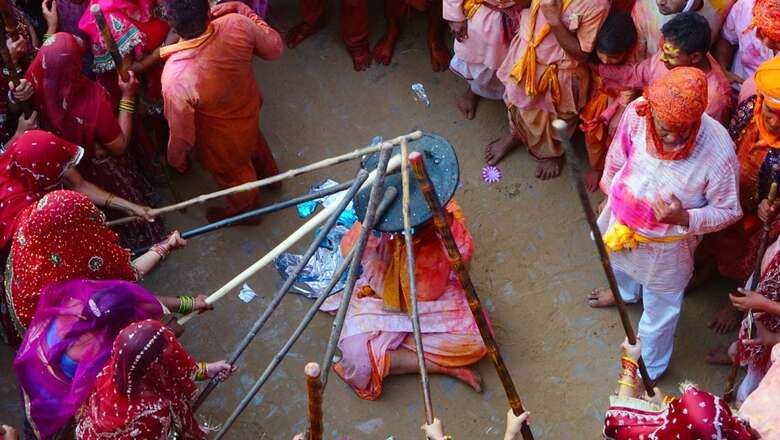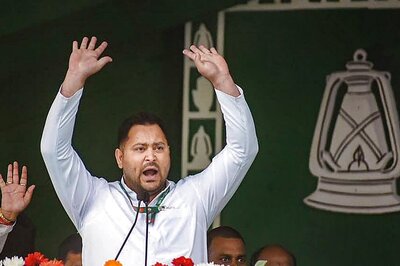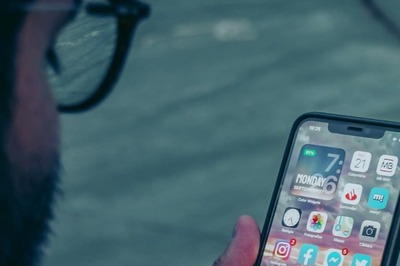
views
HOLI 2023: India’s vastly diverse culture is one of the key attributes that set it apart from the rest of the world. With different traditional attire, food habits, and cultural festivals for almost every state, even a national festival is celebrated in different ways and at times, with different titles in India. For the auspicious occasion of Holi, let us travel across the states and see how differently the festival is celebrated in India.
Rang Panchami (Maharashtra)
Holi is also known as Shigma or Rang Panchami in Maharashtra. After sundown on Purnima, the celebrations begin with the lighting of a firewood pyre (burning Holika), signifying good winning over evil. The next day is ‘Rang Panchami,’ when people apply colour – ‘gulaal – and spray water on each other. You can also expect Puran Poli, a lip-smacking delicacy of the state on this occasion.
IN PICS: Unique Holi Traditions
Royal Holi (Rajasthan)
Moving north to Udaipur, Rajasthan, inhabitants follow the traditional Holika Dahan ritual, however in a somewhat different way. The royal Mewar family of Udaipur organises the celebrations, which are renowned to be exceedingly magnificent. As part of the festivities, there is a massive procession that includes several decked horses and the royal band. Later, the traditional fire is kindled, and a Holika effigy is set on fire.
Hola Mohalla (Punjab)
As we travel further north to Sadda Punjab, things get more exciting. Holi is referred to as Holla Mohalla in this region. It is a day following Holi and is a commemoration of the valour of Sikh Warriors. The Nihang Sikhs, a particular sect of Sikhs, are noted for their festivals. The celebrations begin with a large display of traditional martial arts, followed by music and dancing.’
Lathmar Holi (Uttar Pradesh)
Holi celebrations in the largest state of India are one of the most interesting. Lathmar Holi, as it is known in local Bhojpuri, takes a unique approach to the Holi celebrations. Women are armed with lathis, which are canes that are used to beat men and boys in a playful manner during the festivities.
The males, on the other hand, arrive carrying a dhal, or shield, to defend themselves. Unlucky guys who are caught by the women are forced to dress up as women and dance in the streets.
All of this is done in good fun. The origins of Lathmar Holi can be traced back to Hindu mythology. Lord Krishna is said to have sought to tease Radha by playing Holi with her in Barsana. The women in the neighbourhood were enraged and chased him away with lathis.
Kahila Holi or Khadi Holi or Baithaki Holi (Uttarakhand)
When we arrive in Uttarakhand, our final destination in North India, we learn that Holi is known by a variety of names here. The holiday is also known by the names Baithaki Holi, Mahila Holi, and Khadi Holi.
Traditional costume is worn by revellers who sing and dance to folk tunes playing across the city throughout the festivities. Locals greet each other by putting colour on their faces and dancing and singing all the way.
Phagua (Bihar)
Let us now move eastwards to Bihar, where Holi is known as Phaguwa in the native Bhojpuri dialect. Holika Dahan, like in many other Indian states, is an important component of the festivities. Holika Dahan ceremonies are comparable to those in other states. Holi is celebrated the following day with wet and dry colours, traditional music, and folk songs all day.
Manjal Kuli (Kerala)
Holi is not as popular in the south as it is in other areas. Kerala, on the other hand, has its own set of festivals around this time, complete with traditional folk songs and turmeric-based watercolours. Locals, particularly from the Konkani and Kudumbi populations, attend the temple on the first day and continue the celebrations on the second day.
Dol Jatra/Basanta Utsav (West Bengal)
The land of the roshogolla calls this festival Dol Jatra or Basanta utsav. Basant is Bengali for spring, while Utsav is Bengali for celebration. Women wear a lot of yellow, which is a colour that represents abundance. Shantiniketan in Bolpur, made popular by the revered Tagore family, is the best place to witness the grand celebrations.
The Holi celebrations in this city are unrivalled to this day. There are also poetry performances made famous by Rabindranath Tagore and traditional song and dance programmes, in addition to the numerous colours that are usually a part of Holi. Dol Jatra is observed the day following Holi. A spectacular procession of Lord Krishna is carried through the streets of Bengal on this day, accompanied by singing and dancing revellers.
Shigmo (Goa)
Shigmo is the name of Goa’s spring celebration. Apart from playing with colours, it is planned as a large carnival with traditional folk songs and street dances. Because Goa is a coastal state where fishing is the main source of income, fishermen’s boats are brightly painted with religious and mythical themes.
Read all the Latest Lifestyle News here




















Comments
0 comment